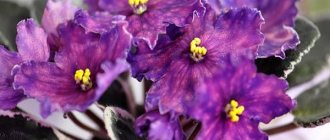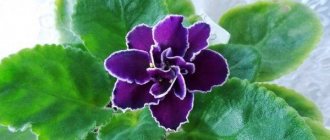Each plant is unique, and often even varieties of the same species are very different from each other . When buying a new individual, it is important to know:
- How to properly care for her;
- What will she look like when she grows up?
- And what surprises it can present to the owner.
Most Saintpaulias are similar to each other , but an individual approach to each of them guarantees an excellent result. In the article you will see a photo and description of Saintpaulia Marble Rose.
Violet Marble Rose (S. Farbitnik)
Fascinating violet Marble rose.
Marble rose is a violet of Usambor, genus Saintpaulia hybrid, family Gesneriev, class dicotyledonous, division flowering. The variety was bred by Sofia Farbitnik .
The rosette is standard size, about 25-28 cm in diameter. Sheets:
- Very dark, green shade;
- Glossy;
- Round with a heart-shaped base.
Flowering is abundant, but gradual. There are usually a lot of peduncles , and there are also buds on them, but before the next flower opens, the previous one begins to fade.
The color is fancy, the flowers are double and semi-double. The main tone is white and pink with a crimson-red marble pattern.
The size of the flowers is large, up to 7 cm, but the more abundant the flowering, the smaller they are.
The variety is resistant to difficult conditions , and even in the heat it blooms successfully, producing 2-3 peduncles with a bunch of buds. The variety is not slow to grow, but the young plant requires attention.
Attention! The first flowering is usually sparse and reaches its maximum extent at least by the third time.
Violet Red River
Ampel Saintpaulia or Uzambara violet, bred by N. Andreeva, blooms in abundance with 3-centimeter semi-double flowers of an unusual red hue for the culture. According to the author's description, the flowering of the Red River violet will be more intense and vibrant if the plant is located in a well-lit place.
Closer to wilting, the corollas acquire a lilac or crimson color. A characteristic feature of the variety is active growth and unusual foliage color. On the green background, and especially along the edge of the leaf rosette, golden touches are clearly visible.
Caring for a plant at home
In matters of care, the Marble Rose is not demanding. Flowering responds to certain maintenance parameters by changing the size and color of flowers.
For good flowering, the variety requires proper care.
Conditions of detention
Violets naturally grow in warm, humid forests. The main conditions for good growth and flowering of the rosette are :
- Lighting – Saintpaulias prefer a lot of light. The lighting should be bright but diffuse. With the natural option, you need to avoid direct sunlight on the flower. Daylight hours are:
- In summer – 12-14 hours;
- In winter – 8-10 hours.
- Temperature – the mode completely depends on the season and the needs of the flower:
- In summer it is maintained at 24° ± 2;
In winter about 18° ± 2.
During transition seasons the temperature changes gradually ; sudden changes should be avoided;
Important! Sometimes, when growing exhibition specimens, flower growers change seasonal flower care. There are cases when the temperature regime and the length of daylight are adjusted depending on the behavior of the individual, so in winter conditions that are characteristic of summer can be maintained.
- Air humidity – Saintpaulias need high humidity. It is important to adjust the moisture level depending on the temperature; the colder it is, the lower the humidity should be and vice versa, an increase in temperature allows for a higher percentage of moisture;
You can collect soil for violets yourself. - Priming – in nature, violets grow on very light and breathable soils. When planting in a pot, it is better to give preference to specialized substrates. If you prepare it at home, you need to mix:
- 3 parts peat,
3 parts primer,
- 3 parts perlite,
- 2 parts sphagnum moss.
For wick irrigation, use a mixture of peat and perlite in equal parts without adding other components.
Watering and fertilizing
The watering regime is very important, and you need to remember that water ingress:
- May leave burns on leaves;
- And at the point of growth cause rotting.
Three methods of watering are used , on which the frequency of fertilizing depends:
- In a tray - the pots stand on a tray or trays 1-1.5 cm deep, and water is poured there, after watering the remainder is drained. The concentration of fertilizers for such irrigation should be half the recommended one. Watering frequency is on average once a week, and fertilizing every other watering;
- Under the leaves - water is poured through the soil, avoiding contact with the leaves. The frequency of watering and fertilizing conditions are the same as in the previous method;
- Wick – a wick is placed in a pot, removed through the drainage holes and lowered into a container of water. Fertilizers are constantly added to the water in quantities that are 7-8 times less than recommended.
Transplantation, pruning, rejuvenation
Young plants are regularly replanted , as they grow, usually they are simply transferred to a larger pot. Adult Saintpaulias are usually replanted once a year, with a complete replacement of the soil.
Saintpaulias need to be replanted once a year.
When replanting mature flowers, they are usually pruned and rejuvenated . First of all, remove the old ones:
- Leaves;
- Peduncles;
- And roots.
Leaves and peduncles are trimmed as needed, regardless of transplantation. If the rosette has aged or the stem has become very long, it is cut off by removing the lower part . If roots remain on the rosette, it is simply replanted, and if pruning occurs high, then the top is first rooted.
Violet Rosie Ruffles
The Rosie Ruffles violet, bred by D. Harrington, is a standard sized rosette consisting of pubescent green leaves with a wavy shape. The main advantage of the variety is its large star-shaped flowers. The color of the flowers is a light fuchsia shade. The edge is densely corrugated, lace.
Often gardeners are faced with the fact that children and rooted tops of rosettes do not retain the wavy edge of the petals inherent in the variety, and the decorative effect does not return as Saintpaulia grows. But when you place Rosie Ruffles violet plants on a cool windowsill, you can get a bright green border on the flowers.
Features of flowering, growth and reproduction
Marble rose grows quite quickly:
- From baby to adult it takes about 10-12 months;
- And the first flowering occurs even earlier.
This variety blooms very profusely, but it is very difficult to achieve bouquet or cap flowering from it . This is due to the gradual blooming of flowers. Peduncles:
- Powerful;
- Medium height;
- Each one contains many buds.
But while the next one blooms, the previous one fades. Each flower lasts about a week, sometimes longer.
Depending on the lighting, the color of the flowers may vary slightly:
- The warmer and more light, the darker the flowers become and the less noticeable the pattern;
- And when the temperature drops and the lighting dims, the pattern is clearer and the light parts are larger.
Important! In hot weather there may be a decrease in flower size, but this can also happen if there are a large number of buds.
Many gardeners propagate Saintpaulias by leaf.
Varietal characteristics are transmitted by all methods of reproduction :
- Leaves - healthy leaf cuttings, cut in 3-4 rows, are rooted in a convenient way. Each cutting can produce 1-3 babies, which are planted and further grown;
- Peduncles - live, not withered peduncles, cut to a size of 1.5 cm below the receptacle node and 0.5 cm above, planted in the ground under the greenhouse. After rooting and formation of the children, they are seated and then cared for like other Saintpaulias;
- Seeds - they are sown in a greenhouse, and after germination they are further grown in such conditions. Next, the children are seated in separate pots and cared for like adult violets;
- Stepchildren - stepsons are formed in the leaf axils; after 4-6 leaves appear, they are cut off and rooted. Some gardeners deepen the mother plant until the stepson touches the ground and wait for the roots to appear on the latter.
Reviews
Alexandra. “The variety is very persistent and unpretentious. After the purchase, I quickly got used to the conditions in the apartment and the new type of watering (switched to a wick). The first flowering was very pleasing. The flowers were immediately large, but it produced only two peduncles of 3 flowers each. The second time there were a lot of flower stalks, but it was either hot or there were a lot of buds, but the flowers became a little smaller.
Marble rose is a very simple variety to propagate. I practice only leaf cuttings (stepchildren spoil the appearance of the rosette; seeds and flower stalks are very difficult). I had 2-4 children on each sheet, which made me very happy.”
Igor Sergeevich. “This variety has proven itself very well. Despite the lack of special care, the rosette is very beautiful, and the flowers are large and fluffy. I just started propagating, I put the leaves in moss on a wick, the first roots have already appeared. For three years now I have been trying to get cap flowering from it, but so far without success. It’s important to me that the Marble Rose is not afraid of heat, because in my summer it’s very hot and a lot of Saintpaulias just disappear.”
This variety has captivated many gardeners with its beauty.
Violet Lituanica
The delicate pink flowers of the Lituanica violet will not leave any lover of this indoor plant indifferent. The variety selected by Butene forms a standard rosette of pointed, medium-sized leaves of an even, green color.
Due to their elongated petals, double flowers resemble dahlias in shape, and the corollas are made more unusual by the richer color of the tips of the petals. A very beautiful plant, named Lituanica in honor of the plane that took part in the flight from America to Kaunas in 1933. Lituanica violet blooms profusely, but grows rather slowly as the rosette matures.
Diseases and pests
If the conditions of maintenance and care are violated, the following may occur:
- Rot;
- Late blight infection;
- Powdery mildew;
- Burns.
Also, violets are not immune to some pests , for example, spider mites.
To avoid illness, it is important to strictly follow all the rules of care and remember:
- Overwatering leads to rot;
- Late blight and powdery mildew - develops in cold and very wet conditions;
- Burns occur when exposed to direct sunlight or dew drops on the leaves.











